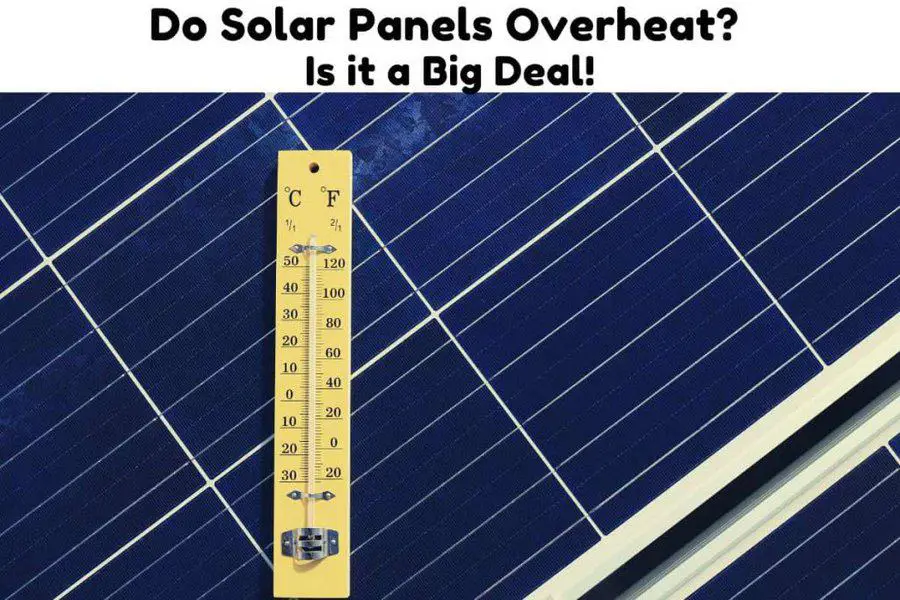On a hot summer day, a solar panel can get as hot as 65°C or 150°F. Like touching the hood of a black car it’s enough to give you a low-grade burn if you hold it for a few seconds. Other than a minor degree burn, what effect does temperature have on a solar panel?
Solar panels can overheat with the result of this being a reduction in the panel’s efficiency. The hotter a solar panel gets, the less energy it will produce. Most people are under the impression solar panels convert heat into energy but this could not be further from the truth.
The photovoltaic solar panels you use to run the appliances in your home operate with light and not heat. High temperatures impair the functioning of a solar panel. This is in contrast to thermal solar panels which as the name suggests, heat water by absorbing heat from the sun.
But how hot can a solar panel get and is there anything you can do to stop your solar panel from overheating?
On a side note! If you’re in need of a reliable and high-performance portable solar panel, We strongly recommend the Jackery SolarSaga 100W Portable Solar Panel (Amazon Link).
With a high conversion efficiency and foldable design, this solar panel is easy to transport and set up, making it perfect for outdoor activities like camping, hiking, and RV trips.

The US solar cell technology used in this panel ensures that you get the most efficient and reliable solar charging possible.
There is also a 60W option that is more affordable (Amazon Link)

What Is The Maximum Temperature A Solar Panel Can Withstand?
Solar panels can reach temperatures of up to 65°C or 150°F. Fortunately, solar panels are designed to withstand extreme weather elements like hail, wind, and heat. They will still work despite the heat and they will not incur significant long-term damage as a result.
Solar panels are put under what is known as Standard Test Conditions or STCs. These are performance test conditions that all solar panels have to pass before they are market-ready. STCs tell us how a solar panel should perform when:
- It is exposed to a solar irradiance of 1000 watts per square meter.
- At a temperature of 25°C.
How Does Temperature Affect A Solar Panel?
High temperatures reduce the energy output of a solar panel. As the temperature in a solar panel increases, the energy it produces will decrease. Solar panels used for the purpose of generating electricity are called photovoltaic as they need light to produce electricity.
Solar panels are performance tested at a temperature of 25°C. The power rating you see on a solar panel is for that temperature or lower. For instance, a solar panel rated at 350 watts will have an output of 350 watts at 25°C or less.
Temperature coefficient of a solar panel
The temperature coefficient of a solar panel is a measure of the decrease in output of a solar panel as a result of an increase in temperature. With every 1°C rise in temperature over 25°C, a solar panel has a reduced efficiency and generates less electricity. (Source)
Most solar panels have a temperature coefficient of between -0.2 to -0.5% per °C. Let’s say you have a solar panel rated at 300 watts with a starting efficiency of 20% and a coefficient of -0.5%, here is what this would look like in practice.
| TEMPERATURE °C | COEFFICIENT % | TOTAL EFFICIENCY % | ENERGY OUTPUT WATTS |
|---|---|---|---|
| 25 | 0 | 20 | 300 |
| 26 | -0.5 | 19.5 | 298.5 |
| 27 | -1 | 19 | 297 |
| 28 | -1.5 | 18.5 | 295 |
| 29 | -2 | 18 | 294 |
| 30 | -2.5 | 17.5 | 292.5 |
| 31 | -3 | 17 | 291 |
| 32 | -3.5 | 16.5 | 289.5 |
The drop in power output is small even when you get to temperatures as high as 35°C. Average temperatures in the U.S are around 22.2°C. The hottest states (Louisiana and Texas) reach a maximum of around 27.3°C. (Source)
Also, check out “Can You Use A Magnifying Glass On A Solar Panel? How To Amplify A Solar Panel!“
How Do You Keep Solar Panels From Overheating?
The effect of overheating on solar panels is negligible. They are designed to operate in high temperatures and have a tolerance of up to 65°C. They will produce energy but with a small decrease in efficiency.
Unless you live in the Death Valley, where the hottest recorded temperature is 54°C, temperature coefficient and overheating solar panels are not factors you need to be particularly concerned about. Average temperatures in the U.S are lower than the 25°C at which a solar panel is tested.
Can Flexible Solar Panels Overheat?
As with rigid solar panels, flexible solar panels can overheat and suffer marginal efficiency losses. Heat will cause the solar panel to produce less energy. In some cases, the solar panel may buckle or warp if it is made from cheap backing material like low-quality plastic.
How Do You Cool Down Solar Panels?
The most effective ways to keep solar panels cool is to install them in a way that maximizes airflow and in an environment that does not trap excess heat. This involves the use of an air gap and making small adjustments in the installation of solar panels.
Those are the simplest and cheapest ways to keep your solar panels cooler. Let’s look at how you would implement each of these methods.
Solar panel installation
To get the maximum power output from a solar panel there are three things you need to optimize for during installation. These are:
- Location or where you put the solar panels.
- Orientation or which direction the solar panels face.
- Angle or the tilt at which the solar panels are fixed.
To reduce the temperature at which your solar panels have to operate there is one simple thing you can do during installation. This is to have a gap between the solar panels and the roof. Why the gap?
A gap of between 4 to 6 inches allows for airflow. The airflow allows for the hot air that would otherwise be trapped between the solar panel and the roof to be carried away. This creates a cooling effect that you would not see if the solar panels were flush against the roof.
Having solar panels tight against the roof, means the solar panels are absorbing some of the heat absorbed by the roof as well. Fortunately, solar racking or mounting creates the necessary air gap between panel and roof. (Source)
On a side note, we also recommend that you check out our post titled Can A Solar Panel Be Too Big? Should You Oversize Your Solar System!
Roof material
The type of roof can also play a part in keeping solar panels cooler. Certain types of roofs absorb more heat and consequently have a higher ambient temperature. The coolest roofs are metal roofs. They reflect more heat than they absorb.
Asphalt shingle roofs are warmer while tile roofs absorb the most heat. Another factor to consider is the color of the roof material. A lighter-colored roof will reflect light and generate less heat. (Source)
There are several other ways you can keep solar panels cooler, like fitting an aluminum water cooling jacket to your solar panels for example. Generally, however, the time and effort involved produce minimal returns.
